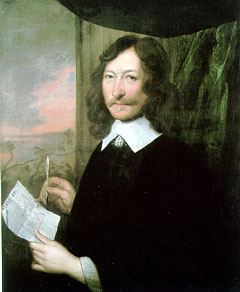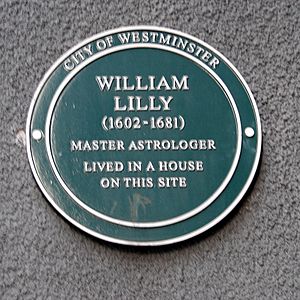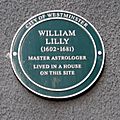William Lilly facts for kids
Quick facts for kids
William Lilly
|
|
|---|---|

Portrait of Lilly, aged 45, now housed in the Ashmolean Museum at Oxford
|
|
| Born | 1 May 1602 Diseworth, Leicestershire, England
|
| Died | 9 June 1681 (aged 79) Hersham, Surrey, England
|
| Occupation | Astrologer, author, translator astrological consultant |
| Known for | Prophecy, astrological prediction, propaganda of English Civil War |
William Lilly (11 May [O.S. 1 May] 1602 – 9 June 1681) was an English astrologer who lived in the 1600s. He was known for his amazing skills in astrology, which is the study of how the positions of stars and planets might influence events on Earth. Lilly became the most important astrologer in England. He had a lasting impact on how astrology developed in the Western world.
William Lilly was born to a farmer in Leicestershire. When he was young, he moved to London to work as a servant. After seven years, he married his former boss's widow. This gave him enough money and free time to study astrology. In 1644, during the English Civil War, he started publishing popular books about astrology.
In 1647, he released a huge book called Christian Astrology. This book explained many astrological techniques. It was special because it was one of the first astrology books printed in English, not Latin. People said it taught "a nation in crisis in the language of the stars." By 1659, Lilly was very famous. His yearly almanac (a book with predictions and useful information) sold about 30,000 copies each year!
Lilly wrote his life story, called an autobiography, in 1681. He wrote it because his friend Elias Ashmole asked him to. This book shares interesting details about the politics of his time. It also tells us about other famous people he knew. These details are often not found anywhere else. People in the 1700s called it "one of the most entertaining narratives in our language." It describes people like John Dee and Simon Forman. It also has fun stories about crystals and a fairy queen named Queen Mab.
In his autobiography, Lilly wrote about how Oliver Cromwell supported him. This happened when Lilly faced trouble for making political predictions using astrology. He also wrote about the Great Fire of London in 1666. He was even questioned about the fire. Some people thought he might be involved. This was because 15 years earlier, he had published pictures showing a city on fire with coffins around it.
Lilly was a person who caused a lot of discussion. He had powerful friends who helped him. But he also had enemies. Many members of the Parliament noticed him. Sir Bulstrode Whitelocke, a very important official, supported him. Lilly even dedicated his book Christian Astrology to him. However, Lilly also said that some Members of Parliament tried to cause problems for him in 1651. To his supporters, he was like a wise "English Merlin." But to those who didn't like him, he was called a "juggling wizard and imposter."
Contents
William Lilly's Early Life
Where and When He Was Born
William Lilly was born on May 1, 1602. He grew up in a small village called Diseworth in Leicestershire, England. The old house where his family lived is still there today. It was a good-sized house for that time. However, Lilly's father, who was also named William, had trouble paying for his farm.
By the time William was old enough for school, his mother, Alice, worried about their family's money problems. Still, she wanted her son to get the best education they could afford.
His Education and School Days
Lilly was lucky to get a classical education. He went to the Grammar school in Ashby-de-la-Zouch. His teacher was John Brinsley the elder, who was one of the best teachers of his time. Brinsley was strict but also used encouragement and praise.
By the time Lilly left school in 1619, he was very well educated. He was especially good at Latin. This skill helped him a lot later on. Most astrology books back then were written in Latin.
Lilly hoped to go to Cambridge University. But his father's money problems stopped him. He wrote about how disappointed he was. All his friends from school went to Cambridge, but he could not.
Moving to London and First Job
A lawyer who knew Lilly's father saw how smart William was. He suggested William for a job with Gilbert Wright. Mr. Wright was a master of the Salters' Company in London. He needed a young person who could read and write to be his secretary and servant.
At this time, Lilly's father was in prison because of debt. He was happy for William to leave. He thought William was "good for nothing" on the farm. So, 18-year-old Lilly walked to London with just a few shillings. He walked beside a cart carrying goods. He later said it was a "stormy week, cold and uncomfortable."
Lilly worked for Gilbert Wright for seven years. He was happy to do all kinds of tasks for his master. He took care of Gilbert's wife when she was sick with cancer. She died in 1624. Lilly also survived the terrible Great Plague of London in 1625.
In 1626, his master married again. Her name was Ellen Whitehaire. Before Mr. Wright died in May 1627, he promised Lilly £20 a year for life.
Marriage and New Beginnings
Just a few months after Mr. Wright died, Ellen, his widow, made it clear she wanted to marry again. She had married twice for money before. Now, she wanted someone loving, no matter their social status. Lilly bravely asked her to marry him.
Ellen first said he was too young at 25. But they got married in September of that year. They kept their marriage a secret from her friends and family for two years.
Lilly said he had a happy marriage with Ellen for six years. When she died, she left everything to him. He said it was "considerable," almost £1,000. This was a lot of money back then.
William Lilly's Astrology Career
Starting His Astrological Studies
The money and comfortable life Lilly got from Ellen allowed him free time. He went to talks and sermons in London. In 1632, just before Ellen died, he started studying astrology. He read every book he could find on the subject. He also tried to solve mysteries using his astrological skills.
His Famous Book: Christian Astrology
Lilly's most important book, Christian Astrology, came out in 1647. It was so big that it was published in three separate parts. This book is still popular today and has never stopped being printed. It is seen as a classic text for studying traditional astrology from the Middle Ages.
The book is especially important for horary astrology. This type of astrology tries to predict future events. It also helps understand unknown parts of current situations. It does this by looking at an astrological chart. This chart is made for the exact moment someone asks the astrologer a question. Volume 2 of Christian Astrology has many examples of these charts.
His Impact and Friends
After Christian Astrology, Lilly started publishing his yearly almanacs and other writings. Important members of the Long Parliament paid close attention to his work. Lilly was good friends with Bulstrode Whitelocke, William Lenthall (the speaker of Parliament), and Elias Ashmole. Even John Selden, a famous scholar, seemed to respect him.
Many people at that time believed in astrology. Lilly was different because he dared to predict specific future events.
In 1650, Lilly wrote an introduction for a book by Christopher Heydon. This book, An Astrological Discourse with Mathematical Demonstrations, defended astrology. It was published after Heydon's death, mostly paid for by Elias Ashmole.
Later Life and Legacy
Retirement and Final Years

After the king returned to power in England (the English Restoration), Lilly quickly lost favor. He had supported Parliament, and his predictions often showed this. This did not make the new king happy.
A writer named Samuel Butler made fun of Lilly in his book Hudibras. Butler's character Sidrophel was likely based on Lilly. By this time, Lilly had saved a good amount of money. He bought a small property in Hersham, Surrey. He moved there and used his special talents to practice medicine.
William Lilly died in 1681. In 2003, a special plaque was placed near the old Aldwych tube station in London. This plaque marks the spot where Lilly lived from 1627 to 1665. It honors people who made lasting contributions to society.
Lilly's Influence on Astrology
In 1985, a copy of Lilly's original 1647 Christian Astrology was reprinted. This led to a new interest in astrology in North America and Europe. It also changed how modern astrology was practiced. Olivia Barclay and other British astrologers helped bring Lilly's work back to light. They were important in getting Christian Astrology reprinted.
William Lilly's Published Works
Besides his 36 yearly almanacs published between 1647 and 1682, Lilly wrote many other books. Here are some of his published works:
- Merlinus Anglicus Junior, 1644.
- Supernatural Sights and Apparitions seen in London, June 20th 1644, 1644.
- The Prophecy of the White King, 1644.
- England's Prophetical Merlin, 1644.
- Collections of Prophecies, 1646.
- Christian Astrology, 1647.
- The World's Catastrophe, or Europe's many mutations till 1666, 1647. This book included 'A Whip for Wharton'. Some copies also had translations by Elias Ashmole. These translations were of The Prophecies of Ambrose Merlin, with a Key and Trithemius, or the Government of the World by presiding Angels.
- An Astrologicall Prediction of the Occurrences in England for the years 1648, 1649, 1650, London, 1648. This book included 'Hamilton's nativity' and was dedicated to the House of Commons.
- Monarchy or No Monarchy, 1651.
- Mr. Lillyes Prognostications of 1667, predicting the Prosperity … of the English and their glorious Victories … by Land and Sea, 1667.
- The dangerous Condition of the United Provinces prognosticated, 1672.
- Mr. Lillies late Prophecy come to pass concerning the present War and the late unseasonableness of the Weather, 1673.
- Mr. Lillies Prophesie of a General Peace, 1674.
- Mr. Lillies Prophecy, or a sober Prediction of a Peace between the French and the Dutch and their Allies, 1675.
- Anima Astrologiae, or a Guide for Astrologers, 1676. This was translated from works by Guido Bonatus and Cardan. It also had a new table of fixed stars.
- Mr Lillies Astrological Predictions for 1677, proving the happy Condition of this our Nation for the Year ensuing, 1676.
- Mr. Lillies Prediction concerning the many lamentable Fires which have lately happened, with a full Account of Fires at Home and Abroad, 1676.
- Strange News from the East, or a sober Account of the Comet or blazing Star that has been seen several Mornings of late, 1677.
- Lillies New Prophecy relating to the Year, 1678.
- William Lilly's History of His Life and Times by William Lilly, 1681.
- Fore-Warn'd, Fore-Arm'd, or England's Timely Warning in general, and London's in particular, 1682.
- Catastrophe Mundi, Mr. Lilly's Hieroglyphicks exactly cut, 1683. This was a new release of an appendix from Monarchy or No Monarchy, 1651.
Images for kids



